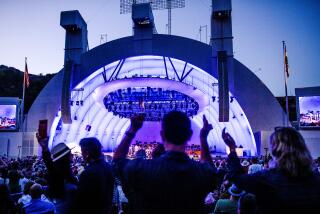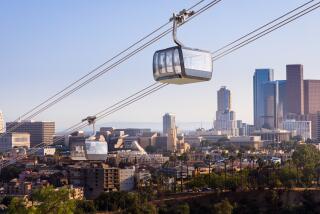Downtown stadium planners release preliminary traffic plan
The public got its first peek Monday at a transportation plan for a proposed 72,000-seat football stadium in downtown Los Angeles.
During a Los Angeles City Council committee meeting, officials with developer Anschutz Entertainment Group laid out preliminary proposals on how to ease traffic congestion and improve public transit near the stadium. They described a parking strategy that would direct game-day drivers to parking zones based on the direction they’re traveling from and explained plans for an AEG-funded expansion of a light rail station on Pico Boulevard.
They did not say what they would do to encourage football fans to use public transportation to get to the stadium, even though a bill passed by state legislators earlier this month requires AEG to reduce car traffic.
As a part of the bill, which limits the timing for legal challenges to the project, the stadium is to be carbon-neutral. Gov. Jerry Brown was expected to sign the bill into law Tuesday at a ceremony near the planned stadium site.
William Delvac, an attorney for AEG, said that in order to meet the carbon-neutral requirement, the firm may purchase carbon offset credits from eco-friendly projects nearby that mitigate global warming.
The transportation plan is still a work in progress and will be released as part of AEG’s environmental impact report in January, Delvac said.
Michael Bates, AEG’s transportation consultant, said his staff is working with the Department of Transportation to study traffic patterns at 180 intersections and 45 freeway ramps.
They’re also looking at parking.
Bates estimates that 81.5% of fans would drive to weekend games, meaning that about 19,500 parking spots would be required on a game day.
He expects that in 2016, when AEG hopes to open the stadium, there should be some 38,350 parking spaces available downtown.
City Councilman Ed Reyes asked why Bates’ parking maps did not include parking west of the 110 Freeway in Pico-Union, even though the area is steps from the stadium and is already used for parking by visitors to AEG’s Staples Center.
Reyes, who represents Pico-Union, said it appeared that consultants were “not focusing on the impact on this side of the freeway.” He asked Bates and Delvac to make sure that residents there are heard on such issues as traffic because their lives stand to be disrupted.
“Their eyes and ears are just as important,” Reyes said.
More to Read
Start your day right
Sign up for Essential California for news, features and recommendations from the L.A. Times and beyond in your inbox six days a week.
You may occasionally receive promotional content from the Los Angeles Times.






